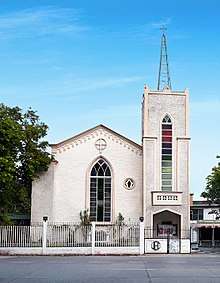Jaro Evangelical Church
The Jaro Evangelical Church is the first and oldest Baptist congregation in the Philippines (first Protestant church outside Manila and second Protestant church in the Philippines both after the Central United Methodist Church (Manila) which was established in 1899). The church was established in 1900 by the Northern American Baptists.
| Jaro Evangelical Church | |
|---|---|
| The First Baptist Church in the Philippines | |
 | |
.svg.png) Jaro Evangelical Church Republic of the Philippines | |
| 10°41′24″N 122°33′0″E | |
| Location | Jaro, Iloilo City, Iloilo |
| Country | Philippines |
| Denomination | Protestant (Baptist) |
| Website | https://jaroevangelicalchurch.org |
| History | |
| Status | Active |
| Founded | 1900 |
| Founder(s) | Eric Lund[1] |
| Architecture | |
| Architectural type | Church |
| Style | American Colonial, semi-gothic |
Jaro Evangelical Church's inception from the beginning is catalyst to the foundation (which it shares a strong association with) of Central Philippine University, the first Baptist and second American university in the Philippines and in Asia through a benevolent grant given by the American industrialist and philanthropist John D. Rockefeller in 1905.
History
With the coming of the Americans with a new political doctrine of separation of church and state, there was no more state church like during the Spanish time. The first Protestant sect to arrive in West Visayas were Baptists.[1]
In 1900, Dr. Eric Lund and Braulio Manikan of the American Baptist Missionary Union arrived in Iloilo City followed by Rev. Charles Briggs.
Manikan was from Aklan but had been converted to Protestantism while in the United States.[1]
In 1900, they both constructed the church in the Philippines. It was a simple bamboo chapel at Castilla Street in Jaro City, Iloilo.[1]
At the same time, Lund and Manikan corroborated by Placido Mata, Vicente Doronila and Pascual Araneta translated the Bible to Hiligaynon vernacular – Ang Bagong Katipan (New Testament) and Ang Daan nga Katipan (Old Testament).[1]
In 1904, Rev. Charles Briggs opened out stations in Pavia, La Paz and Hinaktakan. In 1905, Lund helped organized the Baptist Training School and the Jaro Industrial School (now Central Philippine University), spread to Capiz where they established a Home School (now Filamer Christian University).
In 1923, a new church was built at the Plaza Jaro (the present site). Lastly, in 1950, a newer church (the present one) was built on the same site under Rev. Elmer Fridell. In 1952, the church was finished and was dedicated with Dr. Peter Hugh Lerrigo, the former president of Central Philippine University where he delivered his dedication message.[1]
During the World War II, the church was used by the Japanese Imperial Army. After the war, services resumed in the church where Rev. Vaflor and United States Army Chaplain Weavers preached.[1]
References
- Baptists in Panay. Retrieved 12-18-13